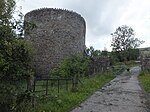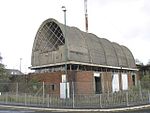Blaina
Geography of Blaenau GwentGwent geography stubsPages with Welsh IPATowns in Blaenau Gwent

Blaina ( BLEYE-nə Welsh: Blaenau Welsh pronunciation: [ˈbleɨnaɨ]) is a small town, situated deep within the South Wales Valleys between Brynmawr and Abertillery in the unitary authority of Blaenau Gwent, ancient parish of Aberystruth, preserved county of Gwent and historic county of Monmouthshire. The place name is derived from the Welsh word blaenau "uplands". As of 2011, the town has a population of 4,808.
Excerpt from the Wikipedia article Blaina (License: CC BY-SA 3.0, Authors, Images).Blaina
Mount Pleasant,
Geographical coordinates (GPS) Address Nearby Places Show on map
Geographical coordinates (GPS)
| Latitude | Longitude |
|---|---|
| N 51.7667 ° | E -3.1667 ° |
Address
Mount Pleasant
Mount Pleasant
NP13 3DD , Nantyglo and Blaina
Wales, United Kingdom
Open on Google Maps









